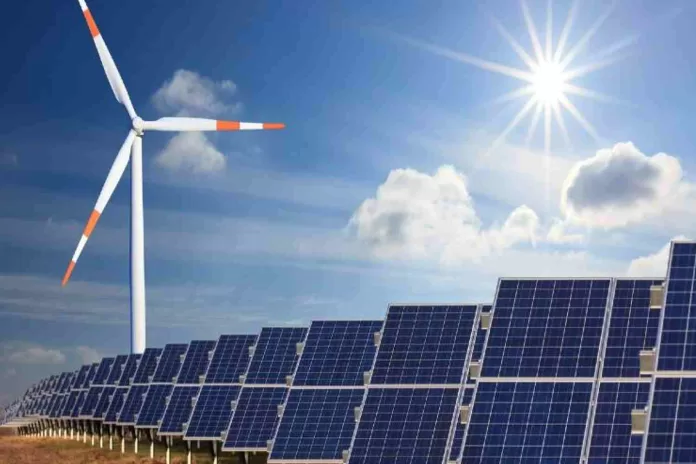Pakistan has the capacity to produce at least 33,000 megawatts of solar and wind energy, or more than 48% of the expected growth in electricity output to roughly 70,000MW in the next 10 years, according to a German research tank’s analysis of the IGCEP 2021–22. According to a newly commissioned Agora research titled “Solar and Wind Roadmap for Pakistan,” this would lead to a 15 percent reduction in generation costs and a nearly 50 percent reduction in emissions.
The report evaluates the likelihood and advantages of pursuing a more ambitious solar and wind power target by 2030–31 and analyses Pakistan’s 10-year generation development programme beyond 2022. According to the study’s hourly dispatch for 2030, it is possible to boost the planned total VRE capacity by adding small grid infrastructure upgrades.
“It offers significant advantages and is steady under all scenarios to increase VRE to 33,000MW by 2030, or 60 percent more than the IGCEP targeted 21,000MW. The yearly tender capacity of solar and wind can be changed flexibly in the future to accommodate any unanticipated changes in demand or other factors, it continues.
According to a German research organisation, Pakistan might produce 33,000MW of solar and wind energy over the next ten years.
The report also suggests including this more challenging goal into the next IGCEP, which is expected in June of this year. Additionally, it recommends pursuing a strategic upgrade of road infrastructure (including the high-voltage direct current link to Chaghai in Balochistan), concentrating on the flexibility of hydro and coal unit operation, and putting into place a strict and regional annual tender plan for auctioning off the 33,000MW of solar and wind power over the course of the NTDC plan.
According to the National Electric Power Regulatory Authority law, the NTDC must annually prepare the IGCEP, which forecasts the scenarios for the supply and demand of electricity in the nation over the following ten years and provides plans to increase power generation from various fuels to meet the rise in demand.
The IGCEP includes NTDC and K-Electric (KE) systems, as well as other power production upgrades needed to fulfil the nation’s anticipated future energy and power needs. Three long-term forecast scenarios are created for GDP growth rates of 3.40 percent, 4.30 percent, and 5.42 percent, respectively.
The NTDC’s “base case” scenario, which takes into account the long-term projection, current contractual commitments, and the retirement of power plants within the planning horizon, served as the foundation for Agora’s VRE recommendations. 8,021MW of current power generating capacity is decommissioned for the study in each of the planning horizon scenarios.
According to the IGCEP executive summary, the demand and installed capacity for the entire nation in the base scenario are predicted by the IGCEP to be 41,338MW and 69,372MW, respectively, by 2031.
It is important to note that the optimised proportion of VRE in the future installed capacity is 20,548 MW, with 13,680 MW coming from solar photovoltaic (PV) and 6,868 MW from wind. In 2031, it will make up nearly 30% of all expected installed generating capacity. This is consistent with the 2019 Alternative Energy Plan, which aims to raise the amount of renewable energy in the fuel mix for power generation from the current 7 percent to 20 percent by 2025 and 30 percent by 2030.
The key elements of the IGCEP base scenario include aggressive VRE inclusion, minimum reliance on imported fuels, i.e., coal, RLNG, and residual furnace oil (RFO), increasing proportion of hydropower as well as local coal, and optimised generation based on local resources.
According to the IGCEP, the addition of VREs, hydropower, and local coal would help reduce the system’s total basket price, ultimately giving customers the much-needed relief they need.
There are currently 41,239MW of installed generating capacity in the nation, of which 3,319MW are generated by KE. The capacity of the committed projects will be 14,159 MW, compared to 17,812 MW for the prospective projects.
Pakistan has always relied heavily on hydropower. To balance supply and demand, large capacity have been built to thermal plants throughout the years using coal, heavy fuel oil, gas, and nuclear energy. Apart than a little amount of native gas and coal, all fuels are imported. With a proportion of 1 percent and 4 percent, respectively, in the total energy mix, solar and wind power are still in their infancy.
The Agora research, carried out by energy professionals working on or in Pakistan’s energy industry, described the IGCEP as being significantly more advanced than the previous edition in terms of wind and solar power at 7,000MW and 14,000MW, respectively. It still contains sizable additional investments in nearby coal and other fossil fuel plants, though.
For countries like Pakistan that depend on imported energy, the situation has completely changed as a result of changes in the global energy market since the beginning of 2022. Imported coal and gas prices have almost doubled, increasing Pakistan’s electricity generation costs and consumer prices and frequently resulting in planned loadshedding to reduce energy import costs, which has exacerbated the current account deficit.
According to the Agora analysis, the growth in VRE does not require the grid infrastructure to be upgraded to accommodate evacuation capabilities. The planned VRE capacity may use existing infrastructure because it is spread out across the nation at various voltage levels. Furthermore, 1,000MW of PV nameplate capacity are often connected to 0.8-0.9GW of evacuation capacity with a tiny level of curtailment, the report notes, making feeder-based and net metering plants exempt from the need for transmission grid infrastructure.





